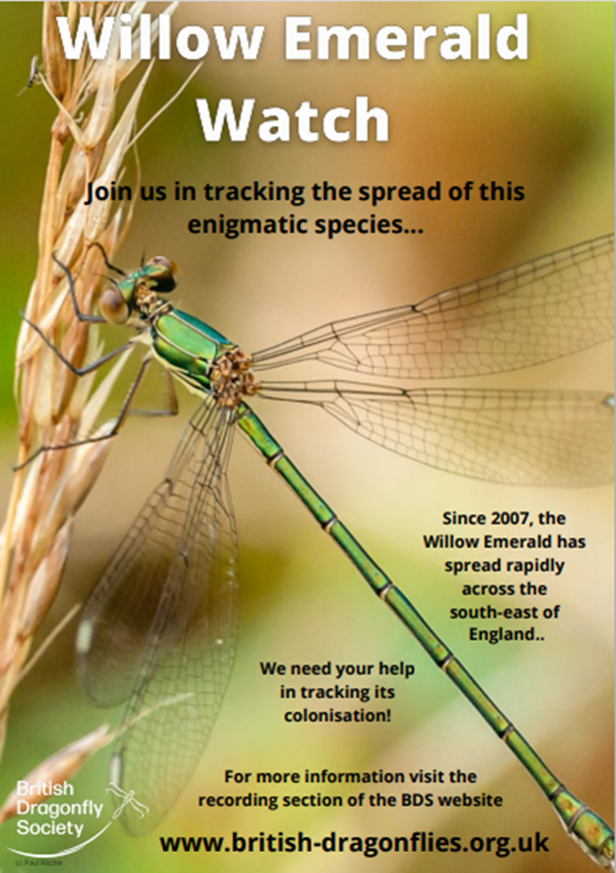Join us in tracking the remarkable spread of this enigmatic species…
Just a decade ago, the Willow Emerald Damselfly had only been reliably recorded in the UK on 2 occasions, in 1979 and 1992. A single individual was then recorded in south east Suffolk during 2007, followed in 2009 by a sudden boom of 400 records of the species from this same general area (SE Suffolk/NE Essex). Since this time, the Willow Emerald has spread rapidly across the south-east of England, gaining footholds in new counties on a yearly basis.
The natural colonisation and spread of this damselfly in the UK is incredible. It is important we track the species in order to understand how it is spreading so rapidly and what might limit the species in the future. For this reason, the BDS have developed the ‘Willow Emerald Watch’ project.
The project so far
Thanks to the efforts of our volunteer dragonfly recorders, we have been able to closely follow the spread of the Willow Emerald Damselfly since those first mass sightings in 2009.
2015: The spread was steady at first but since 2014 the rate of expansion increased rapidly and in 2015 the species was found in 8 counties: Suffolk, Norfolk, Essex, Kent, Cambridgeshire, Hertfordshire, Surrey and west Sussex.
2016: the species colonised yet further new counties, including Bedfordshire, Lincolnshire, Northamptonshire and Buckinghamshire.
2017: was a good year with populations strengthening and spreading within newly colonised counties.
2018: gaps within the current distribution were filled in by expanding populations.
2019: A big surge north was noted along the east coast, with sightings as far as Harwood Dale in North Yorkshire, 150 km further north than the previous year’s range boundary. Significant westerly expansion also took place, with records from e.g. Wytham Woods to the west of Oxford and from near Coventry in Warwickshire.
2020: Relatively little new range expansion was seen, though the first records for Nottinghamshire were received during September (at e.g. Rampton), and sightings from new areas of Leicestershire (e.g. Melton Mowbray) were also forthcoming. Considerable consolidation did, however, take place near the edge of the species’ main range. Sightings continued to come from both north Lincolnshire and east Yorkshire, following the first sightings there in 2019. This strongly suggests that these more northerly areas have now been successfully colonised. Elsewhere, there was a further record from Warwickshire during September, and a number of new sites for the species were identified in the Oxfordshire area, for example at the Trap Grounds in north Oxford and on Otmoor. Further records also came from Buckinghamshire, Berkshire and north Hampshire (e.g. at Yateley Common). The number of Sussex records also continued to increase, with the gap in distribution previously seen in the High Weald area now beginning to close.
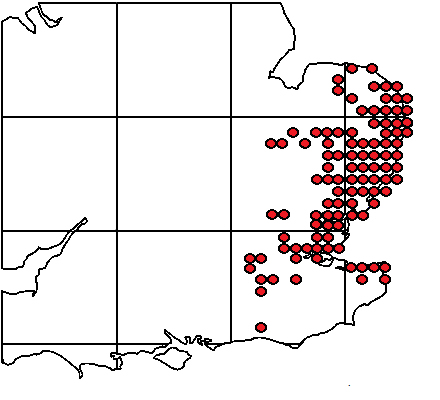
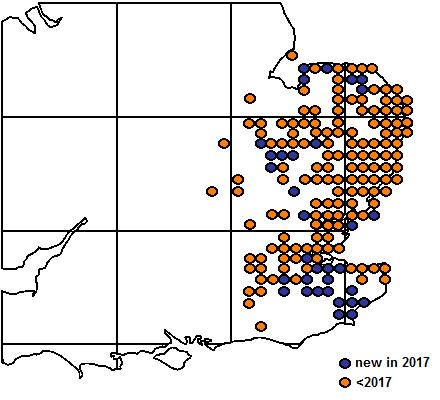
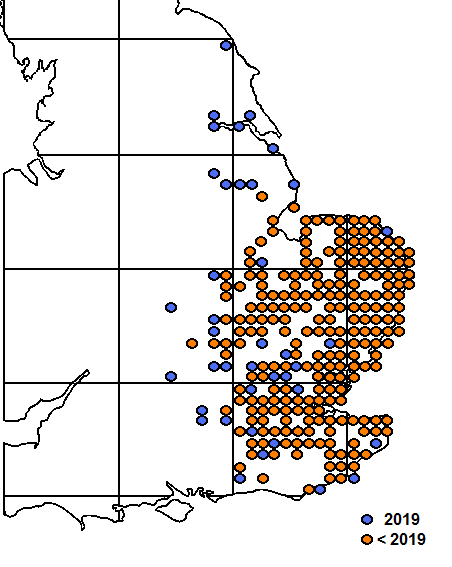
Map comparing pre-2019 and 2019 Willow Emerald Damselfly records. (Adrian Parr)
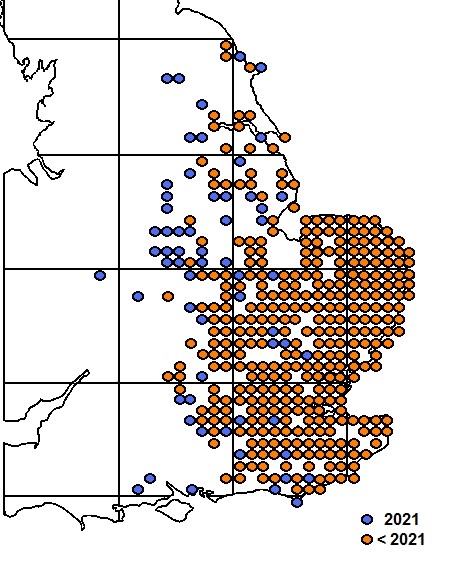
Map comparing pre-2021 and 2021 Willow Emerald Damselfly records. (Adrian Parr)
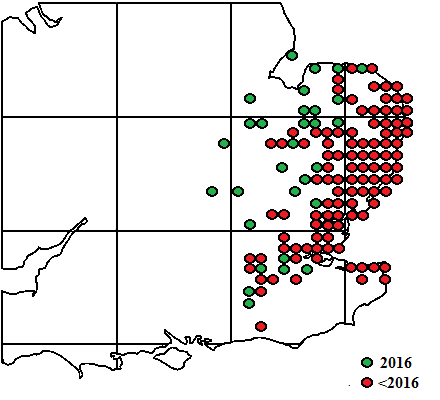
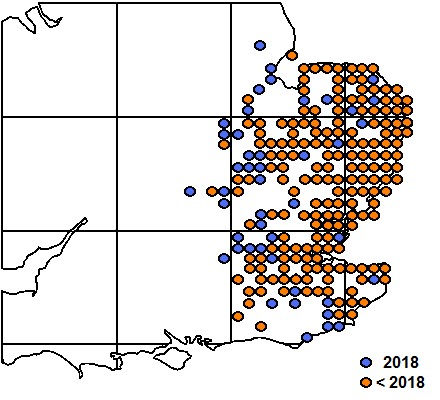
Map comparing pre-2018 and 2018 Willow Emerald Damselfly records. (Adrian Parr)
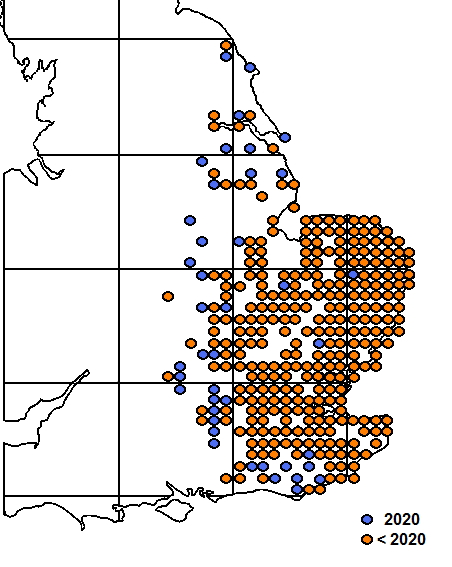
Map comparing pre-2020 and 2020 Willow Emerald Damselfly records. (Adrian Parr)
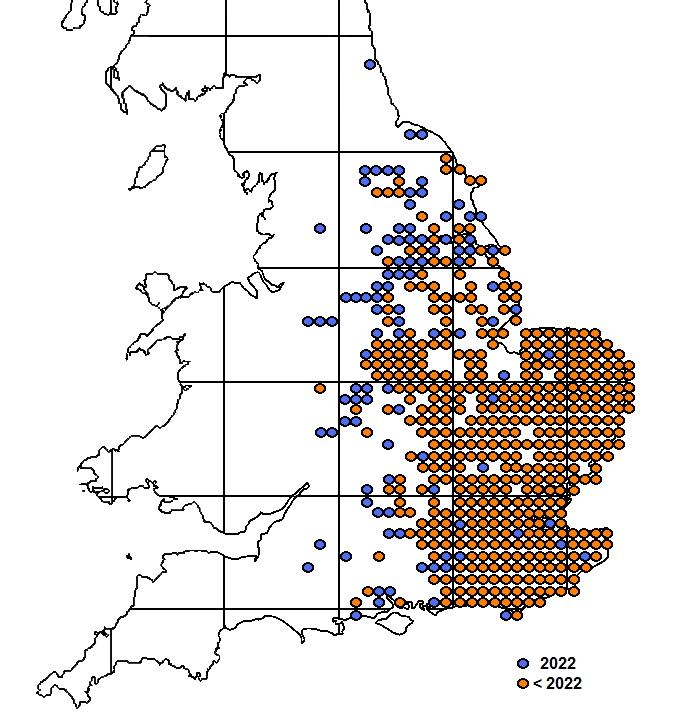
Map comparing pre-2022 and 2022 Willow Emerald Damselfly records. (Adrian Parr)
Update from 2023
Willow Emeralds had another relatively good season in 2023, and it was pleasing to see the large number of oviposition tracts discovered during the autumn/winter months, emphasising the usefulness of this approach in monitoring the species’ spread. In contrast to many of the last few years, further range expansion however appeared limited, though there was still consolidation near the edge of the main range boundary. The most northerly sightings of the year were from Rainton Meadows, Co. Durham, on 13 September and 9 October. These aren’t quite as far north as the record from Gosforth made in October 2022, but it shows the species still has a foothold in these very northerly parts of England. Further south, notable discoveries from new areas included records from Coombe Hill in Gloucestershire on 28 August and 8 October, and from Kyre Park in Worcestershire on 3 September. Probably the most important find of 2023 was when a young male was seen and photographed near Severn Beach in Gloucestershire on 26 June; this now becomes the new most westerly British record. The very early date raises the possibility that this individual could be from a recently established local population rather than simply being a wanderer. Since little is currently known about when and how Willow Emeralds disperse, no firm conclusions can, however, be drawn. What is clear is that this record is within sight of the Welsh coast, and the first Welsh records of the species may thus not be far away. Further developments in Britain are awaited with interest, especially as, given the recent long term trends, it seems likely that range expansion will resume again in 2024.

Map comparing pre-2023 and 2023 Willow Emerald Damselfly records. (Adrian Parr)
Get involved
We are keen to continue following the progress of this beautiful little damselfly and we need your help. We are recruiting as many volunteers as possible to get involved with recording the Willow Emerald Damselfly, in particular in those counties bordering the species’ range so far. You can give as much or as little time to the project as you like; all records of the Willow Emerald help to build on what we know of this fascinating new species in the UK.
What to look for
The Willow Emerald Damselfly is one of four emerald damselfly species which can be found in the UK. The species in the group are well known for sitting with their wings partly open when at rest, as compared to other damselflies which generally rest with closed wings. One of the emerald species is very common, the Emerald Damselfly, two are rare, the Southern Emerald Damselfly and the Scarce Emerald Damselfly, and the fourth is the Willow Emerald Damselfly. The species are fairly similar in appearance and it can be easiest to take photos of any emeralds you are not sure of and have a closer look at these at home.
Willow Emerald Damselfly (Chalcolestes viridis)
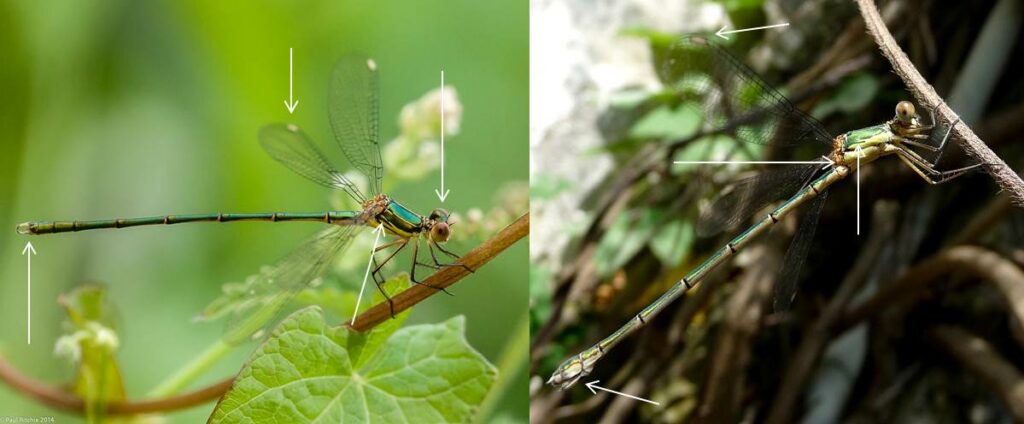
The easily visible distinctive features are:
- the metallic green body without any sign of blue colouring on the male or the female
- the brown eyes
- the pale wing spots with a dark border
- the large spur-shape dark green mark on the side of the thorax
- the outer anal appendages of the male Willow Emerald Damselfly are pale with a dark tip while the inner are dark and very short
- the females’ ovipositor is dark with a pale patch on the underside and chunky
- there are two triangular shaped dark marks on the top of the female’s abdomen
Emerald Damselfly (Lestes sponsa)

When mature, this species has:
- dark wing spots
- blue colouring
- blue eyes on the male
- a very small green spur on the side of the thorax of both sexes.
Other identification features:
- the anal appendages of the male are all dark, and the inner appendages are long and finger-like
- the female ovipositor is dark on the underside and less chunky than the Willow Emerald Damselfly’s.
- there are two small rounded dark spots on the top of the females’ abdomen.
Immature individuals lack the blue colour and can have pale wing spots for the first few days, so some care is needed to correctly identify emerald damselfly species at the start of their flight period.
Scarce Emerald Damselfly (Lestes dryas)
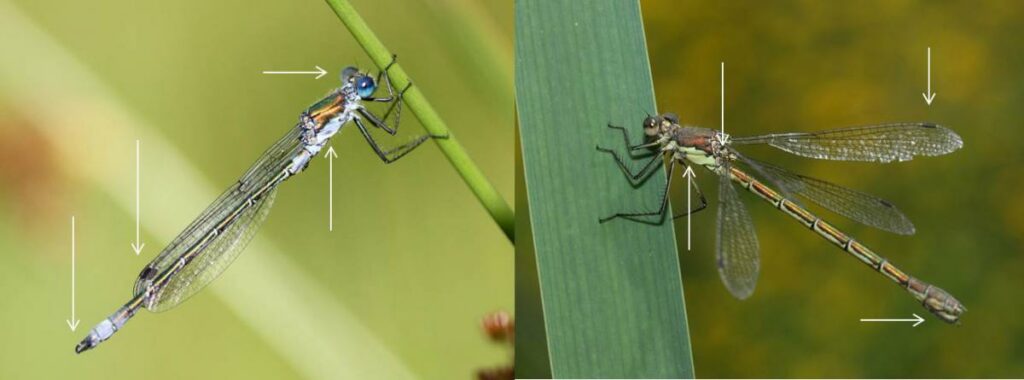
When mature the species has:
- blue colouring
- blue eyes on the mal
- a small spur on the side of the thorax of both sexes
- dark wing spots on both the male and female
Other identification features:
- the anal appendages of the male are all dark, but the inner appendages are spoon-shaped and incurving at the tip
- the female ovipositor is chunky, protruding beyond the end of the abdomen, and dark on the underside
- the female also has two very small square, dark marks at the top of the abdomen
This species is rare in the UK.
Southern Emerald Damselfly (Lestes barbarus)
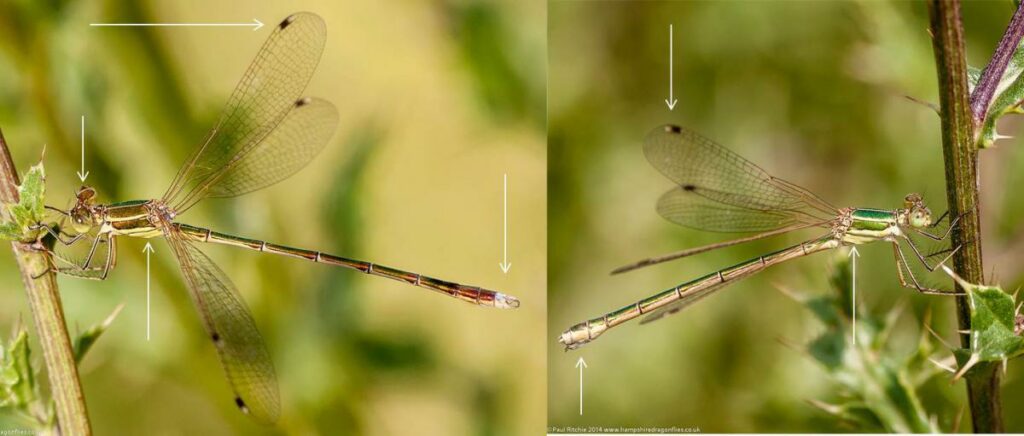
When mature this species has:
- bi-coloured wing spots
- little blue colouring
- brown eyes on the male
- no spur on the side of the thorax
Other identification features:
- the outer anal appendages of the male are also pale with a dark tip, but the inner appendages are paler than the Willow Emerald Damselfly’s and curved outwards
- the underside of the female ovipositor is pale all over.
This species is very rare in the UK.
Egg-laying sites

Willow Emerald Damselfly females lay eggs into the bark of trees; these eggs overwinter and then with the coming of spring they hatch and the larva falls into the water below. Therefore, also look out for the scars left behind by egg laying females on the branches of trees, particularly Willows and Alders, though a very wide range of species can be utilised. The presence of egg scars can be used to record the species even during the winter months, giving the most recent breeding season year as the date of the record.
Where and when to look
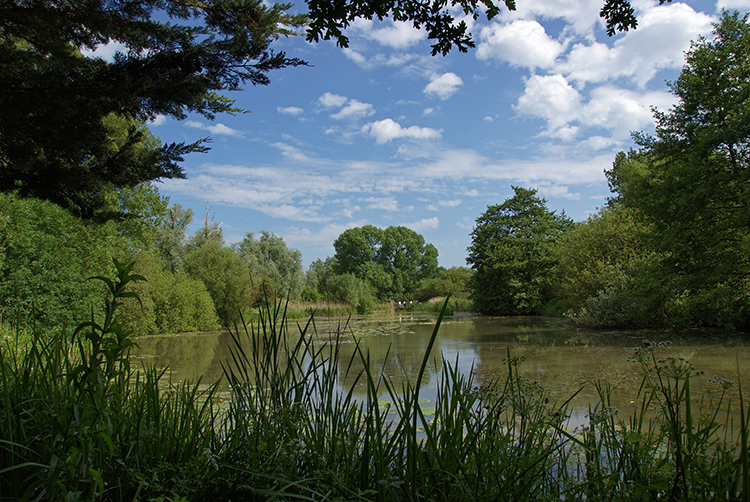
The Willow Emerald Damselfly is unique in the UK due to its behaviour of spending the majority of its time basking on waterside trees, largely Willow and Alder. They are particularly fond of bare, leafless areas of trees which receive maximum sunlight. Willow Emerald Damselflies are usually found near ponds, canals and other still or slowly-flowing waters with overhanging trees.
The Willow Emerald is a mid-summer to mid-autumn species, with most records arriving between July and October, and some individuals even being seen as late as early November. Warm, dry and windless days will offer the best views of the species.
Recording
Record what species you saw, where you saw it, when you saw it and who you are. It is also useful to include a photo with your record, making sure the distinctive characters of the species are visible. To see the female ovipositor, the photo should be taken side on. In addition to this, extra information is useful to record, such as the number of individuals seen. Breeding behaviour witnessed is also an important addition to your record, for example egg laying pairs of males and females.
Where to send your record
Enter your record straight into our database
Want your sighting checked first? Contact the Project Co-ordinator, Adrian Parr (adrian.parr@btinternet.com), or the relevant BDS Local Dragonfly Recorder
Thank you for taking part!
Image: Willow Emerald Damselflies mating by Pierre Bornand

